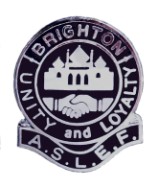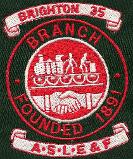EVERY PICTURE TELLS A STORY
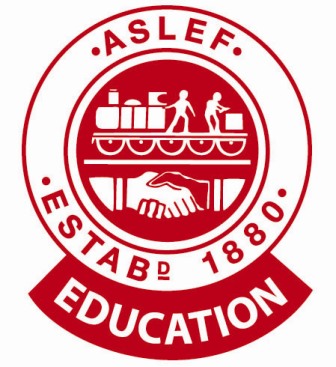 |
One of the main reasons for doing these web sites is to try and explain to everybody the history of the footplate grades, the conditions they had to work in and the creation of the A.S.L.E.F. branches within the Brighton & Sussex area. I am therefore very grateful for people sending me personal photos from their personal collection and for allowing me to display them on the web sites. But unfortunately what is missing, are the stories that accompany them. What I want to do is to try and remedy this by starting to record the remaining stories that are still out there, before they too are lost in the midst of time. I have added some information about some of the drivers that I know and the comments that have already have been sent to me. If you too have any stories about your own working life on the footplate, the people that you worked with and the conditions you had to work in please send me and I will post, on the web site. If you are interested in helping me in capturing these stories by any means possible please let me know. |
STORIES FROM THE SHOVEL
My Newhaven Days
By Newhaven Engine Cleaner, Fireman & Passed Fireman
Ron Terrill
When I was 12, I asked my dad if I could join the sea cadets, he said “providing I could come up with the subs”. So I went to our local newspaper shop “Whites” for a job, it entailed me getting up 06:00 hrs. and I had to walk to the (Newhaven) Town station, where I met the ‘paper train’. We loaded the bundles of newspapers on to a wheelbarrow and took them back to the shop to sort out orders prior to them being delivered around the town. I had that job for 4 years unloading the newspaper of the ‘paper train’ at the station. It was during this time where I got to know a man called Ted Evans. Ted allowed me to sell some papers at the station Town station to the commuters. It was only later on after I joined the railway service that I found that Ted was the man that coaled our engines at Newhaven. I carried on with my paper job even though I was now working for the railway, at the time on the railway we could not do shift work until we were 16 years old. By continuing with my paper job, this helped me financially to cope during the 1955 A.S.L.E.F. strike.
My days of work on the A1Xs at Newhaven Loco started very early in my working life as a cleaner when we had to light up the engines fire at 3-30am ready for the driver Booking on at 5-30am. By 6-30am she had enough steam to leave the Depot to take the oil tanks and harbour works wagons over the swing bridge to the west quay and breakwater.
On a trip to the Breakwater was like a military operation. We stood beside the goods shed awaiting the shunters instruction that the Gates were open for us and the traffic had been stopped so that we could proceed foreword with the shunter holding his Red Flag up to and over the swing bridge to the Works compound west of the bridge where we would pick up the supplies for the Lighthouse crew. Then we would proceed to the next set of gates by the Bonded warehouse and sheet loft, then continue on to the Fuel Tank for the Mail Boats, then on to the next gates at (the green light) and when clear continue on to the Breakwater and right down to the Lighthouse where we would run round the train in the loop which was there until 1963 when the West Quay closed, we then returned back to the bridge Works where we had to wait for all traffic to be stopped so we could proceed back across the bridge to North Quay where we shunted the train and returned to the depot where we took on coal and water threw out the fire and stabled for the night.
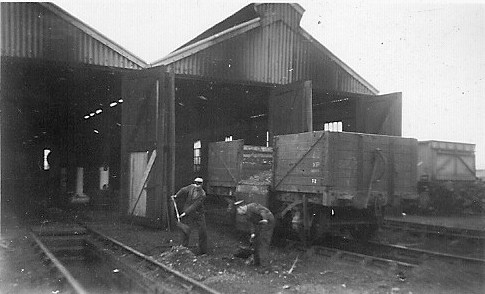
RON TERRILL COLLECTION
Above and below: Firemen Brian Simpson & Ron Terrill shovelling out ashes, cinders etc.,
from the pits roads outside the Newhaven Loco Shed.
I started at Newhaven Loco Shed on the 13th September,1954. If I had started at Brighton Loco Shed I would have been thrown in the deep end and firing from day one. I was taken on at Newhaven as an Engine Boy and worked with boiler-smith Bill Gerard and his mate George Ball for 12 weeks to learn all about the boilers, gauge glasses, lead plugs and the like. I was very curious so I learnt very quickly how to build brick arches and change ferrules on the tube ends.
The next 12 weeks was spent with the Shed’s Fitters Fred Catlin and his mate Fred Rainer our two fitters, where I found out the names of all the bits and pieces of all types of motions (Stephenson’s Link), Walsharts, cabbrotic gear etc. we did a lot of work at Newhaven Depot rather than sending the engines back to the works at Brighton.
For the next six months I worked under Bogie Simmons the Running Foreman and performing shed-duties, like chopping up sleepers with a double head axe for lighting up the fires, keeping the sand-hole furnace filled and hot. Also being a small depot all the engines had to be coaled by hand and all the ashpans and smokebox ashes had to be shoveled out of the pits and into the wagons (as seen in photos right).
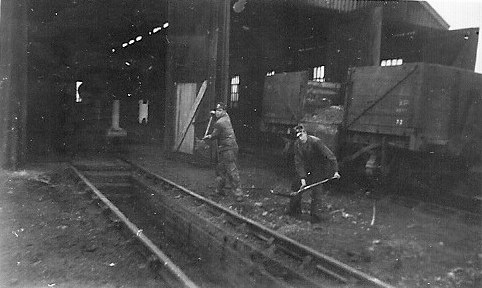
RON TERRILL COLLECTION
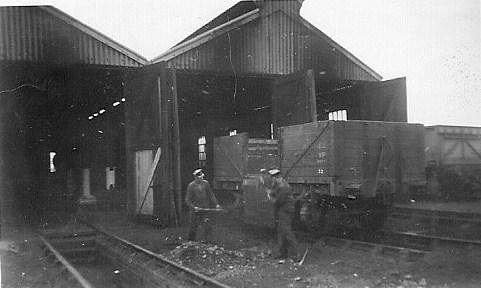
About 1955 it was normal practice for footplateman to have 15per cent of there money deducted for the Railway Bank so as to make them a sure candidate for a later tenancy to rent a house from the company! I did that although it took me until 1963 to get a railway house. (Inwood Crescent) next to Crompton Road, Brighton. It was only a one bed flat but it, was a home! Most of the railway housing in Newhaven was for Harbour employees, about 150 houses in the 1950s. Where I live now is on the opposite side to the houses which were for (the Salaried Staff) only. They were good times then! Now there are only 14 railway houses left the others were taken over by the council or have demolished.
I was glad that after my probation period was up I then went in front of the big man for my exam as a cleaner. The big man Mr. Bert Copp turned out to be quite a small man, but certainly new his job. He was responsible for putting me the first rung of the ladder to become an Engine Driver.
RON "BURGLAR BILL" TERRILL
When I was a cleaner at Newhaven in 1955, a driver Ted Tucknott came in to work where he realised that he had left his locker key at home. The shed foreman at the time was Frank Heritage, and he could not find the locker master key. I thought that I would try and help by trying to make a key. We had still got the fitter’s bench and tools, so I cut out a rough template of the key and to my surprise it worked and opened Ted’s locker, it saved a possible duty cancelation at the time. After this I was known as 'Burglar Bill' .
My burglary activities continued when we moved from the (Brighton) loco works lobby to the new lobby up the stairs, on several occasions Chucks locked himself out of the office and so did Les, and I was successful each time. I never did anything illegal, although I was trained later by a builder who worked for an estate agent to enter properties with the police present.
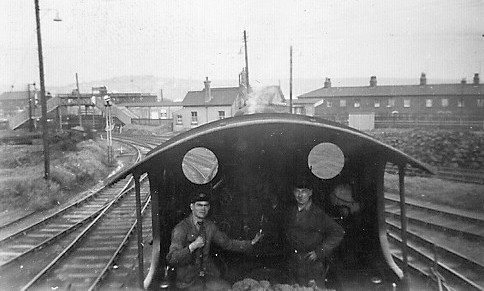
Ron Terrill Collection
Ron Terrill & Johnny White
On the footlplate of a 'H2' Class Atlantic in Newhaven Loco c1955
At this time we had several relief foremen at Newhaven, after the death of Bob Shimmons our Shedmaster in 55/56. The relief foremen included Chuckles (Ernie Southon) and my father Bill. Incidentally when Frank got a railway house at Haywards Heath, he did not need his car any more so I bought it from him for £35, it was an ex-army staff car a Morris 12.
The Loder hut was situated between the Loco & Denton Terrace (where Vic Sexton used to live). Denton Terrace consisted of 4 four story houses next to the Railway inn. the Loder hut. It was of wooden construction and was complete with a stage, after the Second World War, it was used as a cinema, a general meeting place for railway people, I suppose it was similar to the staff club. There use to have shows put on like (magic shows) I remember seeing a Woman being sawn in half on the stage . It was latter then used as a Scout hut.
I wish to tell you about My first girl friend whose parent were scientist (Atomics), they worked at Aldermasten and commuted by train to work until they were transferred to Ellesmere Port in Cheshire, so I lost my girl. Anyway I helped them to take all their domestic belongings to Newhaven Goods Shed where we loaded them into a box wagon and the wagon was taken to Chester by Freight train (I think at the time it wasn't unusual) after all we used to take coffins on the trains quite often. I don't know when that service ceased because we were still doing it on the electrics. I also remember taking a Circus train from Newhaven Harbour to Kensington with Reg Turner!
Incidentally I remember Ben & Dave Renville using a Box Wagon up the Coal Road as a store for Staff Associations first club room in c1954/5, this was before the British Railway Staff Association Club was built. Also on Station Approach Road there was a bikes and a cafe called Lucas, where we used to buy ham rolls for Bob Shimmons our foreman.
When we were the junior cleaners at Newhaven, one of our jobs was to bring all the paper work and driver’s bills (time sheets) from Newhaven to the offices at Brighton loco for Peter Freeman, Jack Barber and Bert Kidwell to do our wages. Charlie green who was our cleaners foreman in 1955, I can remember him catching Brian Tompsett, Frank Moody, John White and myself in the firebox of an Class H2 Atlantic No.32426 'St Albans Head', playing cards,we had two locos stabled at the shed out of steam, in case the hornby broke down. Our punishment was to unload a truck of sand in the sand furnace, heavy work!
As cleaners we had a bin full of pebbles, which we brought back from the West beach by the terrier A1x. We used them to keep the clinker off the bars in the firebox for when we had rubbish coal, some of the coal came from the railway collieries in Kent, Tillmanstone was the worst and Snowden was good. We also had bricketts which were made of compressed anthracite (coal) which was very good, but made a lot of clinker and ash in the smokebox.
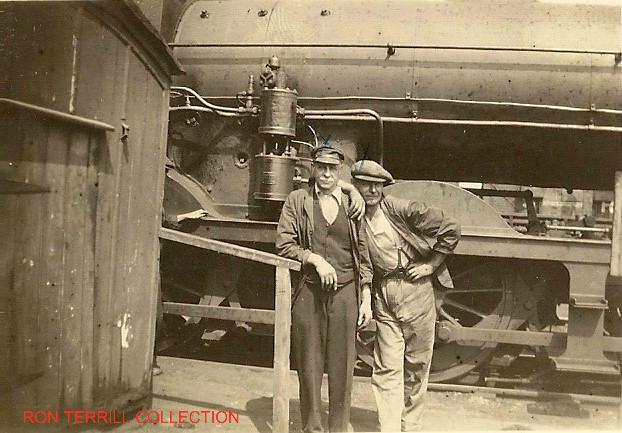
RON TERRILL COLLECTION
Charlie Green & Jack 'Bogey' Simmons
When I was a junior cleaner, it was common place for a cleaner to ride as a third man on an engine. This was always subject to the driver permitted giving his authorisation for the cleaner to ride on his engine. On one such job, was on the Seaford goods, were I went on the footplate to Seaford. At arriving at Seaford, we shunted in the yard and then returned back to as far as Tide Mills. At Tide Mills there was a cattle dock, which held one wagon. We picked up some sheep and took it to the middle yard at Newhaven, where they were attached to the Lewes goods. I had to return back to the loco depot.
I expect they thought Lewes was too far for me!!
When you approach Newhaven from the whistle board to the box on down side, there were two tracks (called cabbage patch sidings)and between them and the road (where the factories are now) we had about 25 allotments for railway staff. When staff were on shed duties they would go and do a bit of digging and plant a few greens. As cleaners when we were free, we used to pick strawberries and chase the rabbits away from the crops. We also used to grow Jerusalem Artichokes instead of potatoes, because they were easier to grow on our allotments and we could harvest them most of the year
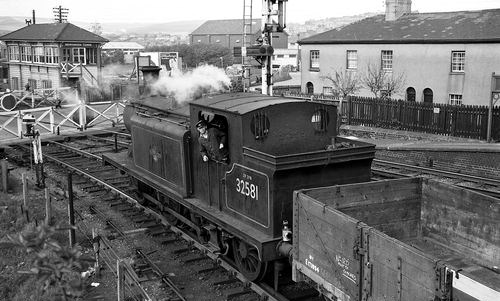
PHOTOGRAPHER UNKNOWN
Engine-man is thought to be Ron Terrill
At the time we were working 48 hours a week, it was not until after the 1955 strike, that we got one weekday off every month (4 weeks), but we had to work 3 weeks of 48 hours to get one week of 40 hours. You had to think about whether it was worth your while to do overtime in the beginning of the week, because if you got back early from a job you didn't get paid your full days pay so you would have to wait until your official booking off time before you could start your overtime rate.
At the time we were working 48 hours a week, it was not until after the 1955 strike, that we got one weekday off every month (4 weeks), but we had to work 3 weeks of 48 hours to get one week of 40 hours.
After the 1955 strike we were very low in Loco coal, at all the depots, we had a stack of coal left from the war years. I remember taking an engine and one wagon (see photo above, I was unaware that a photo was taken or the engine's number at the time) to the gates and reversing up the bank road to the coal stack, where I spent 4 hours loading the wagon and the engines bunker with coal and finally returning to the coal stage in the loco shed were I left it for the coal-man, Ted Evans to unload.
We had a link which was not on the main roster and was known at Newhaven as the ‘3P Link’ (I don't know why for certain). The link was always in pencil and often changed each day. The ‘3P Link’ consisted of three senior ‘Passed Fireman’ and three senior ‘Passed Cleaners’. Bearing in mind you only got paid your lowest rate of pay unless you were upgraded to do a job. It was done on strict seniority then. On reflection I wonder if the 3Ps stood for 'Possible Promotional Payment', because if they didn’t run you got flat pay. The work in the 3P Link was for performing extra work at short notice, like collecting empty wagons from various yards and bringing them back to the ‘Wagon Pool’ at Newhaven. We used to have a pool of wagons at Newhaven which consisted of about 250 common users wagons and about 40 box wagons. The box wagons where used on the ‘Boat Trains’ and were kept in the ‘Wagon Pool’ in case we needed any extra box wagons for boat workings.
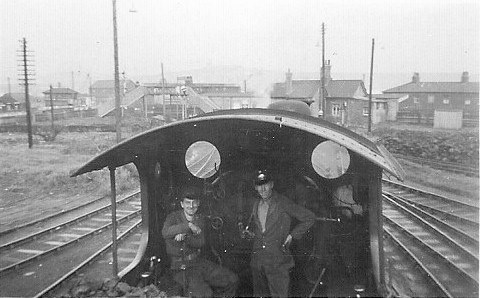
Ron Terrill Collection
Johnny White & Brian Simpson
On the footplate of a 'H2' Class Atlantic in Newhaven Loco c1955
At the time I believe that Newhaven loco had three main line links: - a 'Top link' of 12 men, a dual-link of 8 men (with the men transferring to the Motormen’s depot at Seaford), a 'Freight link' of 12 men and 3 pilots turns that worked the pilot engines for 24 hours a day, and one 'West Quay' job which was worked by a Terrier Tank No. 32636 ‘Fenchurch’, which was one of the regular Terrier engines based at Newhaven and was formerly owned by the Newhaven Harbour Company 1889-1926.
Later on in my career, and whilst training, on the ‘Hornby’s.’ I met Bob Drapper, Jack Macathy and Bert Harding who seemed to be the main men to convert us from steam to electric and to diesels. I enjoyed my years on the steam rather than electric and diesel locos that I ended up driving.
NEWHAVEN HORNBY LOCOS
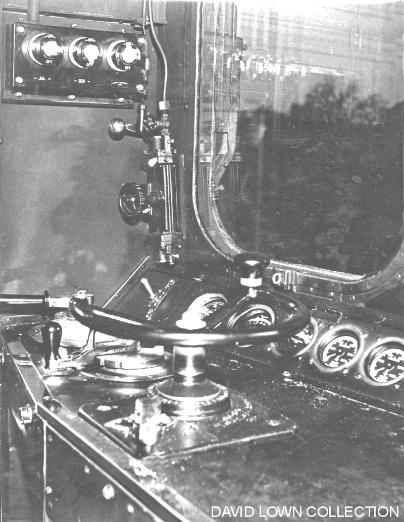 above the cab layout of Bulleid's
above the cab layout of Bulleid's
Electric Loco 'Hornby'
We had a duty at Newhaven with the electric loco Co-Cos (Hornby), we relieved at Newhaven Harbour station and worked the 'Boat Train' to Victoria. On arrival at Victoria the pilot engine took the coaching stock to Yeardly sdgs., and we then went light to Bricklayers Arms via Crystal Palace. On arrival at North Kent East signal box, we had to raise the pantograph to enter the mail dock to pick up two vans, then back to Mercer’s crossing where we would lower the pantograph then back to ‘J’ section, where we then waited for the shunters permission to go back on the train, which meant going off the juice rail and relying on booster power to get us on to the train create the brake, then pull forward to Bricklayers Arms signal box and wait for the banking engine to get on our rear when we got the road the banker. The banking engine stayed with us to Forrest Hill, we carried on to Three Bridges and then on to Lewes East yard, where we left the train and went light engine to Newhaven Marine station.
On occasions we used to bank freights from Bricklayers Arms to Forrest Hill. Even the Hornbys. They didn't need a push, it was in case of if they broke away we were there to stop them.
Whenever we left an engine at Bricklayers Arm loco, the foreman used to supply a couple of Heavies! to escort us to London Bridge station, even if we didn't want them
I remember when we relieved the Boat Train at Newhaven Marine we had to uncouple and run forward off the juice rail into the sidings and then run around the train purely on booster power. The power lasted about 10-15mins on Flywheel so we would cross our fingers everytime hoping we would make it OK. The engine weight was 100tons with a tractive effort of 42000lbs and was built 1941-1945 and the last one 20003 was built at Brighton Works.1948. No 12 road in L.W.S.had a section of overhead wire for pan testing. There was also a wire in the down siding at Balcombe for stabling the Hornby. But servicing for the Hornby was normally done at Stewarts Lane (electric sheds).
When they increased the load on the Hornby’s to equals 117 wagons the load for most trains was equal 85 max. which meant a loaded wagon was 20 tons approx.
Some of my memories about No.1, she had a controller like a Regulater which had a grip device that acted as a dead mans handle, she also had I believe 21 notches in series, and further notches in weak field which you obtained by depressing a block under the controller. We had to take water on board via the water crane the same as we watered class 47s. They had two 1 ton boosters, one of which also run the auxiliary like the boiler heating. The boiler pump for steam heating and of course the Compressers and the Vacuum Exhausters. No1 also had a big knife switch to connect to the juice rail, there was a serious incident at Three Bridges when my driver for the day, was Waters of Horsham loco, he went to cut out the main switch, and he came into contacted with 750 volts, which badly burnt his wrist and had to be taken away by Emergency Service. I also remember ( firing) to Horsham men on trips to Portsmouth Harbour with mail vans.
Locos No2 & 3 had wheel controllers but were otherwise identical to No 1 except for the Pantograph system.
When we eventually got the E5000 class with single booster and Pantograph which we used for Boat train, Parcel trains, and also loose coupled freight.
The introduction of Bo-Bos electric locomotive were introduced in 1958 (Class 71) although we did not get them at Newhaven until about 1960, to work the Boat Trains. They were 3000 H.P. all electric single booster with pantograph and later went to the Western side, where they put a 600H.P. diesel engine in them.
The Boat Train was of course designed for steam working which meant that the heating was supplied by the engine and the lighting was supplied by the generators on the coaches, but gas used by the buffet/car which was supplied from a tanker truck of which we had to shunt the whole train into the sidings to gas it and return to the boat platform. That is why you often see it with an A1x on the front of the train to shunt it to the sidings and back and steam heat the train, plenty of power for 12 coaches & 2 vans. In the early 1960s, the Boat Train was worked by electric multiple units and worked by Newhaven 'Dual Link Men'. The E.M.U. trains finally replaced the Boat Train stock. With the closure of Newhaven shed in 1963, the work moved to Seaford E.M.U.T. depot
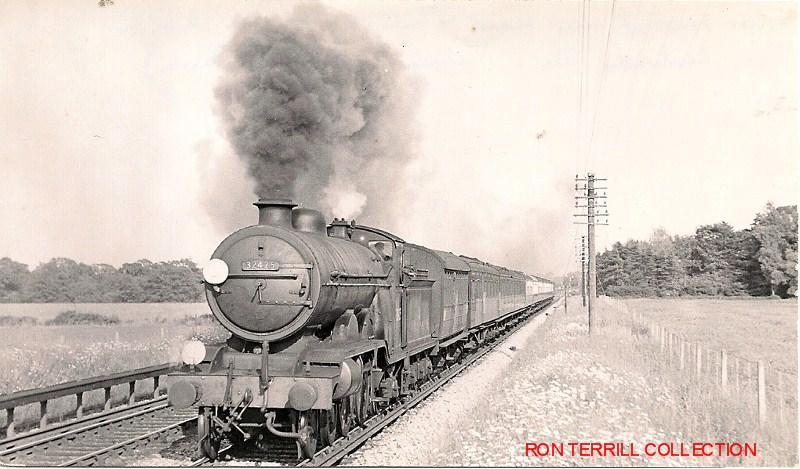
Newhaven Driver Maurice Smith is seen approaching Plumpton station with Class H2 Atlantic No. 32425,
whilst working the 5.48 p.m. Newhaven Harbour to Victoria 'Boat Trian' on the 16th June 1951
DRIVER TOM DENMAM AND FIREMAN TOM HOLDER
I recall a story about a Newhaven loco crew, Driver Tom Denman and his Fireman Tom Holder. Driver Tom Denman was a hard man, who used to put a chalk line down the centre of his cab, this was to keep the fireman of his side of the cab. On one occasion they were working the up ‘Boat Train’ with an Atlantic class locomotive, when the donkey (a pump on a locomotive to create air pressure for the Westinghouse Brake) had stopped working whilst approaching Southerham Junction. The fireman went to front of the engine, because the donkey was under the smokebox to give it a clout with a spanner to restart it and fell off the engine. The Driver continued on to Lewes and phoned Control for another fireman. Poor old Tom had to walk all the way to Lewes to rejoin his engine. On rejoining his engine, his driver said to him where have you been (not how are you) and then blew up for the signal to be cleared, and they continued on to Victoria as if nothing had happened!
They were hard men in those days!!
NEWHAVEN GOODS WORK
Newhaven men used to work across the ‘Romney Marsh’ between Hastings and Ashford, one such turn involved us going tender first to Lewes with a few wagons and a brake van. We would run round at Lewes and then went to Hastings. At Hastings were we picked up a couple of more wagons then carried on to Rye. At Rye we dropped off a couple wagons then we stopped at Appledore and Ham Street where we would do the same. Ham Street at this time was only a coal yard. After leaving Ham Street we went on to Ashford yard. At Ashford we would take the engine onto the loco, whereby we had our P.N.B., and to prepare our engine for the return journey. We usually we had either a German class or a Mogul loco on this turn. We would bring our engine of the loco and go on to the rear of the ‘Birkenhead’, were we would run fast to Hastings then onto Eastbourne. At Eastbourne, Brighton men would take the train fast to Brighton. We would then run light engine to Polegate and picked up a few wagons and made our way to Lewes, where we would leave them and returned light engine back to Newhaven Loco. Newhaven men also use to work ‘Banana Specials’ to St Leonrds West Marina, Hastings and to Rye.
Another thing I remember well was when working back from Ashford with freight trains, we had to stop east of ore tunnel and pin 1 in 5 brakes down on the wagons, otherwise we would not stop at Hastings.
When I went back to Newhaven I went with driver Dave Renville, and several times we took an engine to New X Gate and picked up a couple of wagons that used to come from Shoreditch via the underground, hauled by a condensing steam tank engine, and take them to Norwood Yard then return to New X Gate and bank a freight up to Forrest Hill. Earlier on about 1956 the train from Shoreditch used to be worked by L.N.E.R. men and we as Southern men used to run alongside them at Norwood fork siding. On one occasion we offered them a cup of tea and they were very rude to us saying, we were to young to be working steam engines (even the fireman was about 60 years old), but by the end of the week they excepted us for being so young. Going back to what I said earlier I suppose they stopped signing the road to Norwood.
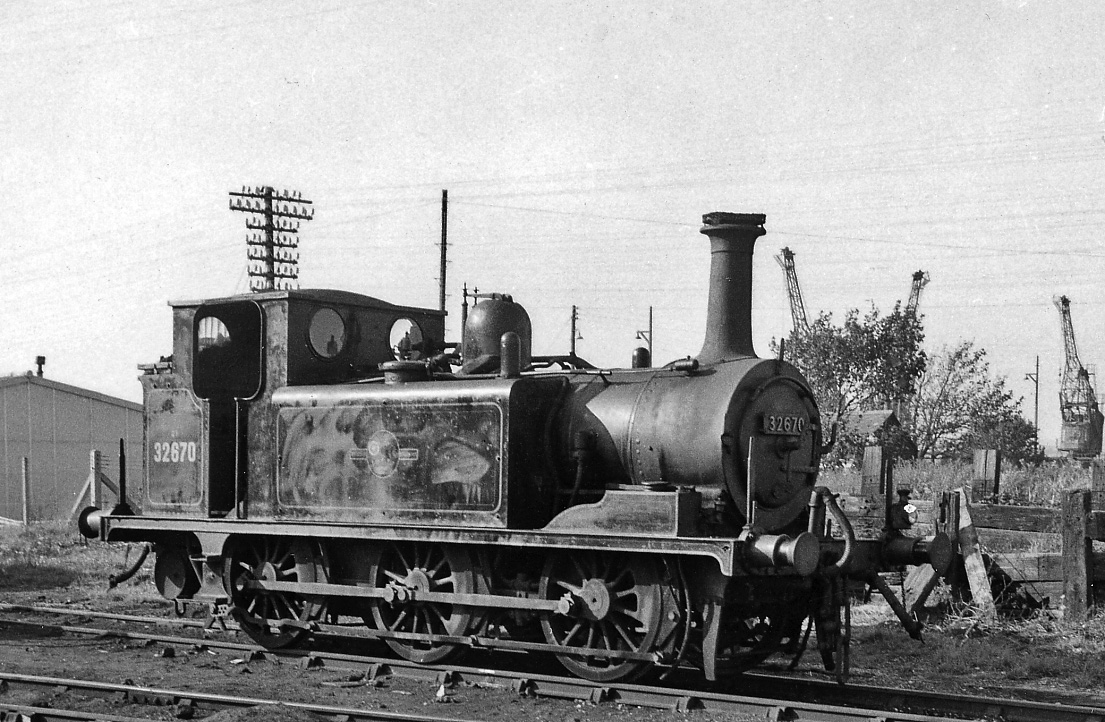
Ben Brooksbank Collection
We had a lot of freight trains from Newhaven's North Quay including timber specials to Mitre Bridge (West London) and then we run light engine back to Stewarts Lane. After disposing the engine we would walk to Battersea Park station and travelled pass to Victoria and come home on the cushions.
We had three coal boats a week arriving at Newhaven, the coal was to supply the local gas works in the East Sussex area.. After the coal had been unloaded into the wagons, we had to shunt each wagon to enable them to be weighed before they were put on to the various trains. Each coal train had about 35 wagons with the train's total weight of approximately 700 tons plus the guard's brake van. These coal trains run regularly to various local gas works such as Galley Hill, Bexhill, Crowborough and Uckfield.
I worked a lot with Ron Herriott, he was a versatile travelling shunter who worked in Seaford yard, Asham yard and of course west Quay and breakwater.
We used to propel coal wagons from the North Quay to the middle yard without a brakeman the common practice of the day was for t
he shunter to ride on the last wagon and to signal when the dummy came off to proceed. To steady himself he would support himself whilst standing on the coal by using his shunting pole dug in. He waved for us to proceed and away we went! On this particular day, as we went around the curve by the Town station, I noticed the shunter Ron Herriott had slowly submerging in the coal (the bottom doors in truck floor had opened,) we stopped as carefully as we could and run to the wagon expecting the worst, by a stroke of luck as the coal poured onto the track and Ron somehow managed to keep his feet on a bar in the floor about 2 feet wide (we laughed about it later) but of course it left a lot of coal on the level crossing.
I also worked with Bob Cobden who became a shunter on the West Quay run. I believe he was employed by the Newhaven Harbour Company to their (general duties) department to do jobs such as emptying the fuel tankers for the Mail Boats when they converted from coal to diesel! And also shunting operations at the Breakwater compound and the goods shed on the East side of the river. I think he ended up as a shunter in the middle yard with Ron Herriot & Earnie Collington, Harry Avis & Harold (Syko) Dunk.
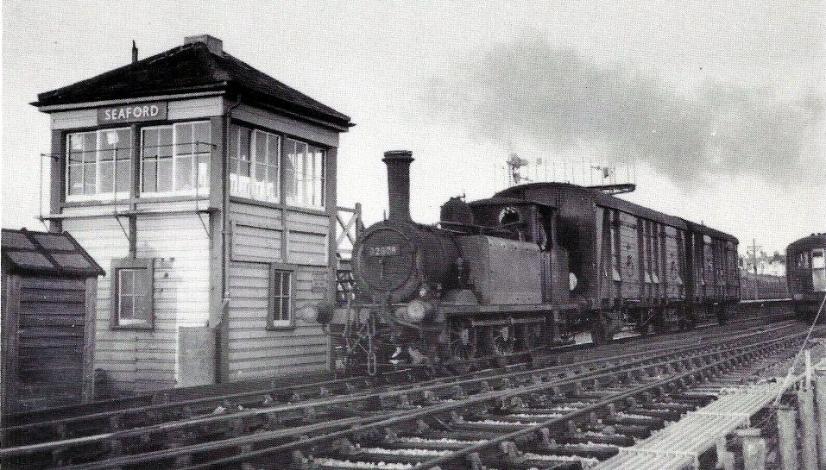
I just remembered another incident involving a fireman who was leaving Seaford with a coal special bound for Galley Hill. His name was Sandy Owen on leaving Seaford he went over the back of the tender to check the water and hit his head on a bridge, but being as tough as old boots he tied a wiper around his head and carried on to Galley Hill. He finally transferred to Waterloo.
One other story about shunting at Seaford yard it was common practice for the fireman to ride the brakevan down pass the weighbridge when the shunter unhooked it, on this occasion I looked out the side window for the weighbridge an put the brake on only to find I had come off the rail and run down the road! We remedied it with a length of rope tied to the engine.
The Locomotive Department Coal which we worked from Ashford to Brighton of course it was only for St Leonards Eastbourne Brighton & Newhaven Depots. The bulk of the coal from (Tilmanstone, Snowden Chislet, & Betteshanger Collieries) went via Redhill or Hither Green. To Bricklayers Arms where it was sent to other depots on our region.
Newhaven Railways had their own Water supply from their pumping station beside the Flying Fish Public House in Denton and it is still there today but I think it now supplies.
One other story about shunting at Seaford yard it was common practice for the fireman to ride the brakevan down pass the weighbridge when the shunter unhooked it, on this occasion I looked out the side window for the weighbridge an put the brake on only to find I had come off the rail and run down the road! We remedied it with a length of rope tied to the engine.
The scrapping of wagons & coaches at Newhaven and Polegate up side required a lot of train movements for us at Newhaven. We picked up wagons and coaches from all over Sussex to be broken up. A lot of wagons were stored at Kingscote and Ardingly Up Road. The underframes of the coaches were used for the first EP stock 57s Haps, Cigs, Bigs & Veps and we used to take them to Eastleigh to be done up. The wagons loaded with the scrap iron we took to Mitre Bridge which was quite a punch up North Pole bank. I never found out where all the brass went. The fires at Newhaven & Polegate seemed to burn for years. A bit like the fires at Drayton after all that landfill.
Ron Terrill Collection
THE OXTED LINES
At Newhaven, we had a lot of workings via Eridge & Oxted because of course they had only juiced from London to Sanderstead so steam prevailed until Dieselisation and most of the workings were covered by Brighton & Newhaven Men! This included an hourly steam Passenger service from Brighton to Tonbridge via Tunbridge Wells Central which when the steam finished we done some work with (Slim line D.E.M.U.s).We also had several passenger turns to Victoria & London Bridge via Eridge and Oxted, which none turn which was returning with the 16:40 to Eastbourne via Oxted, Eridge, Redgate Mill Junction and Hailsham (the Cuckoo Line)
.
We had a turn where we would go pass to Buxted and relieve Tunbridge Wells’s men, usually on a Class C2xlocomotive. We would shunt the yard which, would take about 30 minutes and then after the Brighton passenger train had gone, we would follow it to Uckfield where we would pick up cattle from the Mill dock, then through the gates to the ground frame then shove back to the goods shed. After shunting the gas sidings, we would shunt the coal bins and then the goods shed, afterwards we would then make up the train and continue on to Isfield, where on arrival we would leave the train on the down road and cross over to the up side and pick up anything from Government Sidings. The Government Sidings were on the Lewes side of Isfield signal box, (I don't know if you knew there was an airstrip there) we would shunt the goods yard and return to train then on to Anchor Lane crossing where we dropped off water cans for the gatekeeper (and a bit of coal in winter months) and then on to Barcombe Mills and shunted the sidings and finally continued on to Lewes. At Lewes we would propelled into the West Yard and then we would run round the train and pulled to Lewes East Yard, where we picked up another train and worked back to Newhaven’s Middle Yard where we would chucked off the coupling, and went on to the depot and disposed the engine.
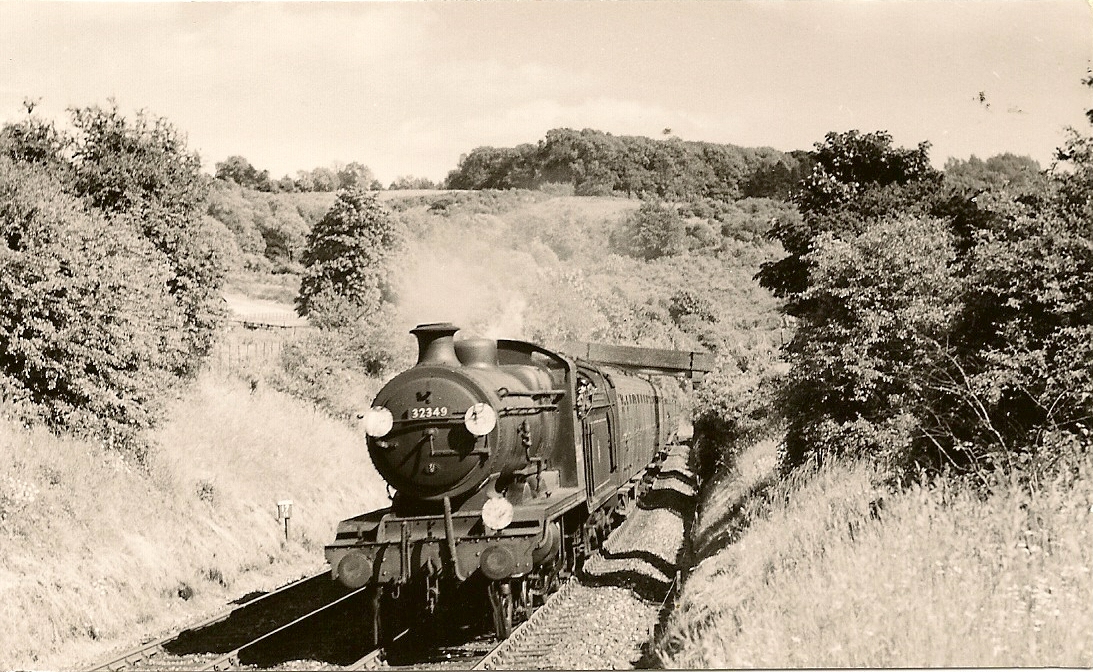
RON TERRILL COLLECTION
3.28 p.m. Haywards Heath - London Bridge near Woldingham.
Working goods trains out of Lewes Yard and then onwards towards Culver Junction, would involve us propelling our train out of Lewes yard and into the tunnel on the up London line, we would then run back through the station up onto the viaduct and headed out of Lewes towards Culver Junction. On arriving at Culver Junction, the signalman would unload a small amount of coal from our tender, this would being for the purpose of his fire in the signal box. After picking up the staff we would continue on to Newick & Chailey and dropped off some coal trucks then on to Sheffield Park to pick up the milk tanks. We would then continue onto East Grinstead High Level making another a further stop at Kingscote to pick up additional wagons. On arriving at East Grinstead High Level we would leave the train and returned light engine back to Lewes, this train was normally worked by class ‘C-2X’ which were commonly known as Vulcans (see the two photos below).
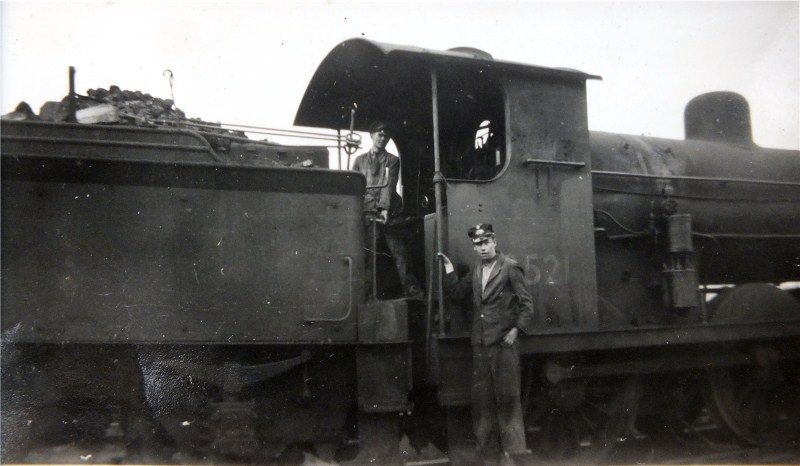
Ron Terrill Collection
Above
Ron Terrill & Brian Simpson at Newhaven in 1955
photographed with a class ‘C-2X’ which were commonly known as Vulcans
Shunting horse boxes at Lewes was a common occurrence, shunting them from the cattle dock on the down Lodon side and attaching them on to the rear of the 'race specials' trains on the up London platform. The horse boxes would be going to the racecourses such as Gatwick. The racecourse at Gatwixk is now part of the airport and the station complex. We would also work other 'horse race specials' which would involve working race trains to Lingfield via Haywards Heath and Horsted Keynes; we usually had a locomotive commonly known as a German pulling these trains.
I remember as a passed cleaner I was called upon to fire to a ‘Top Link’ driver to work a ‘spud’ special to Blackfriars with a radial tank engine E5x class. We had a good journey to London Blackfriars were we picked up a pilot-man from Cricklewood loco and continued on to Dock Junction (just North of St Pancras). We left the train there and returned light engine to London Bridge. At London Bridge we picked up two mail vans and run fast to Redhill where dropped them off and then we run light engine back to Newhaven loco.
We had regular stone/aggregate trains, which included ballast trains. The ballast trains were loaded full of old used ballast; the old ballast was used to help reclaim the land on the shoreline between Tide Mills and Newhaven's East Quay. The aggregate train continued to run up until to the mid-1990s (worked to Crawley New Yard) and the ballast trains continued to run until the mid-1980s.
We worked 'Brick Trains' them from the various Brick yards in Sussex such as :- Newick & Chailey, Crowborough, Cooksbridge, Keymer. Berwick and Southwater. We worked these trains to Bricklayers Arms, were I suppose they trains were for rebuilding London?Several goods trains run from the Harbour station to Battersea & Bricklayers Arms which included the 'mail trains' (hence the mail boats). The incoming trains were agriculture vehicles (such as tractors and combine harvesters etc.) for export and even cars for export, which had to be loaded by crane on to the boats, before the roll on off service started .
I have recognised myself on several engines in the London area that I didn't know existed. One in particular photograph was an engine I left in Stewarts Lane Depot and made a run for it, The engine was 31280 C Class which I had worked a load of Flowers & Fish from Newhaven to Battersea Yard . We went to Stewarts Lane to dispose the engine, we had turned the engine and taken water, and then we went to the coal hopper! My mate went off to find the coal man and came back saying he had gone home! My mate said it must be easy to operate the hopper so off he went and next thing I knew we had 22tons of coal on our tender. My mate could not shut it off, so we made a run for it to Victoria.
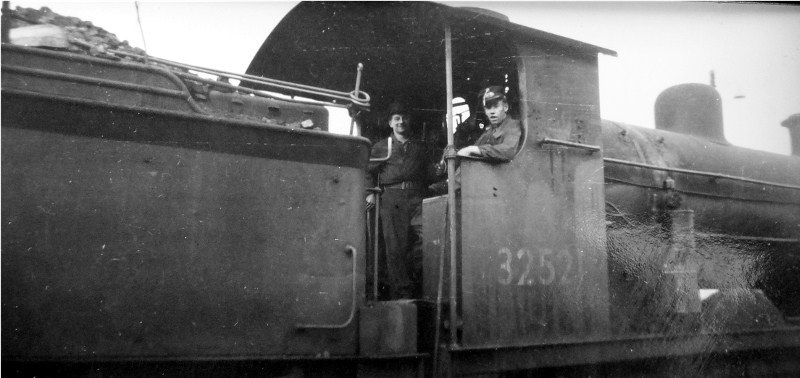
Ron Terrill Collection
Above
Ron Terrill & Brian Simpson at Newhaven in 1955
BALLAST TRAINS
Under British Rail we did all our own repairs to the tracks (no contractors then). On one occasion we went by taxi to Barcombe Mills station, it was a terrible morning with about 6 inches of, snow and we arrived there after about a 40 minutes taxi journey. On arriving we went to the signal box at Barcombe Mills at about 05.05 a.m. We had a quick cup of tea, and asked the signalman where our train was, he said "they were working between him and Isfeld but as he had only just come on duty he was not sure exactly where”. So we started walking towards Isfield where the ballast train should be. Finally we arrived at Isfield station and went into the Signal Box only to find that the job had packed up early and the ballast train was heading towards Lewes. So we got a local taxi and headed of to Lewes where we finally relieved the crew on Every's Bridge (near where Lewes Tesco is now situated). We then took the train on to Three Bridges, where all the ballast trains were stored.
I recalled another occasion when we had a problem on to relieving a ballast train this time we had to relieve a ballast train at Lewes with Tom Holder, the ballast train had been working at Culver Junction all night, when the train arrived at Lewes, Tom was filling up the tender with water. As we had a Q1class locomotive, I asked why he was taking water as we only needed to get to Three Bridges, Tom replied the tender was empty (alarm bells were starting to ring in my head). Sure enough as we left Lewes on the steep climb up towards Cooksbridge, the water level in the boiler was dropping rapidly and with both injectors fully on I could not stop the level from dropping and we had no choice but to stop the engine, just short of a welcome bridge, about half a mile past Cooksbridge. We then got on with the task of chucking the fire out to prevent the plugs from dropping. It turned out that the main steam pipe had been fractured in the night using excessive steam and water. We were finally rescued by driver John Knight and his mate, they were on a ‘N’ class locomotive (I think John’s mate was Jerry Elliot) no relation to Percy Elliot the Coal crane operator at Brighton loco). We never got to Three Bridges yard with our train, as we were dragged to Plumpton and we put the train away into the sidings.
Whilst relaying track between Hamsey Church & Isfield, the old sleepers we took up were cast iron approximately one inch thick and curved on the edges. The rails were bull head and we replaced everything with wooden sleepers, baring in mind it was done by men with picks and shovels, no JCBs. The following night we took a train loaded with ballast (stone) to be unloaded all by hand from ordinary wagons. They finished the job of unloading in seven hours! We helped a little between trips to and fro checking our boiler. Certainly back breaking work.
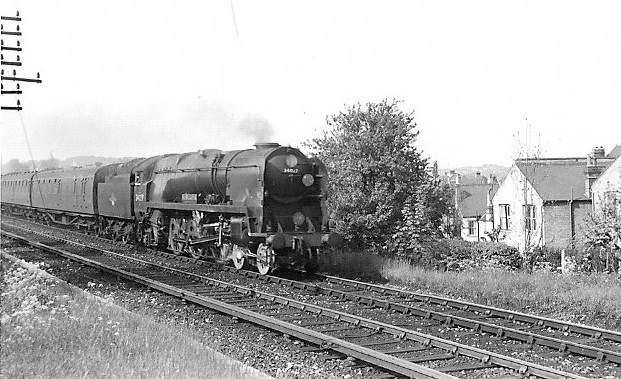
GOING ON LOAN
On many occasions during my loco days, I was booked 'on loan' to various foriegn loco sheds on the Central Division of the Southern Region, working at such Loco sheds as Fratton, Bognor, Eastbourne, Tunbridge Wells West, Redhill, Norwood and Stewarts Lane. By going 'on loan' enable me to achieve another firing/driving credit towards my next rate of pay, we had to achieve 294 credits before going on to the next band.
I remember going ‘on loan’ to Tunbridge Wells West, when I got there the missing fireman turned up and the foreman asked if I was willing to do some shed duties which meant chopping up sleepers for lighting up the Engines, easy job for an extra firing turn then returned home on the cushions.
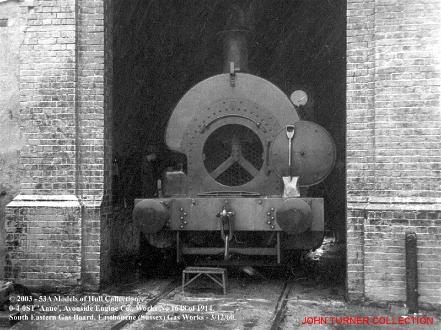 Eastbourne Gas Works Loco 0-4-0ST 'Anne' 03/12/1960. | I also remember going on loan to Eastbourne and lost my way walking around the streets of Eastbourne trying to find my way to the loco shed, we were not allowed to walk along the track. I eventually arrived and went with Eastbourne driver Wally Wood and our loco was a radial E4 tank, we worked a goods train to the Eastbourne gas works (Tescos now occupies the site) on the 'Crumbles' branch line, it was there where I saw for the first time a dry steam engine called 'Anne' (photo left) that they used for gas working only. The steam was provided by the gasworks by a pipe which was connected to the engine which had no firebox it otherwise looked and worked like a normal steam engine. Eastbourne men must be familiar with them. They were just like kettles! |
In the early 55, I went on loan to Nine Elms on a pilot job and saw a cleaner called Joe Brown who became a pop singer (with his bruvvers) The job was the Lamberth Pilot taking coal into Battersea Power Station!
When Ron started at Newhaven Shed, the Shed was a sub shed of Brighton shed (75A) and the Newhaven Shed had an allocation of about 13 engines which included :-
3 Class H2 Atlantics 4-4-2,
2 Class C2x 'Vulcan' engines 0-6-0,
5 Class E 'Radial' tank engines 0-6-2T and
3 Class A1x 'Terrier' tank engines 0-6-0T.
Information about the engines allocated at Newhaven is from Ben Brooksbank (a railway photographer in the 1950s/60s)
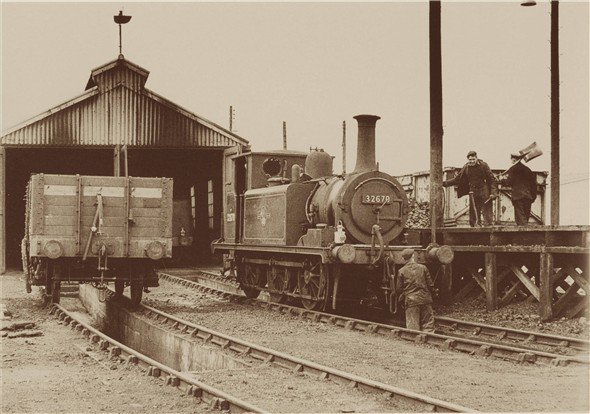
PHOTOGRAPHER UNKNOWN
List below names some of the loco-men at the time of the 1955 A.S.L.E.F., some of the drivers are paired up with their fireman
List compiled by Ron Terrill
|
|
I have tried to indicated some of the depots that Newhaven loco-men moved to after Newhaven loco shed closed


